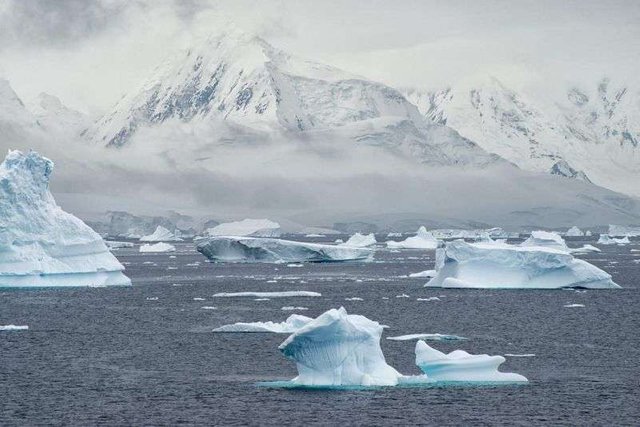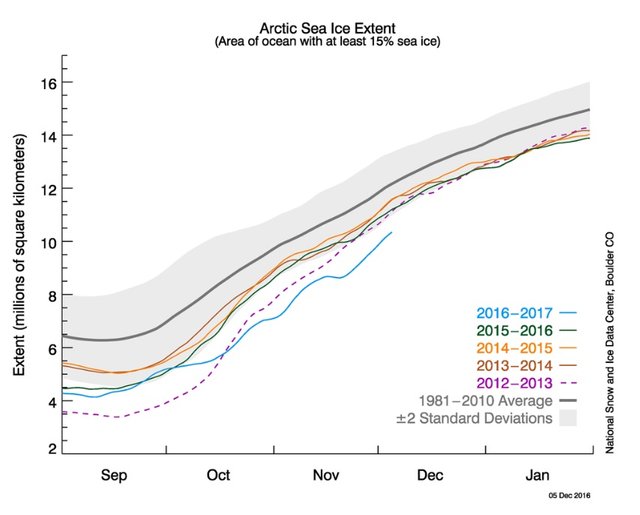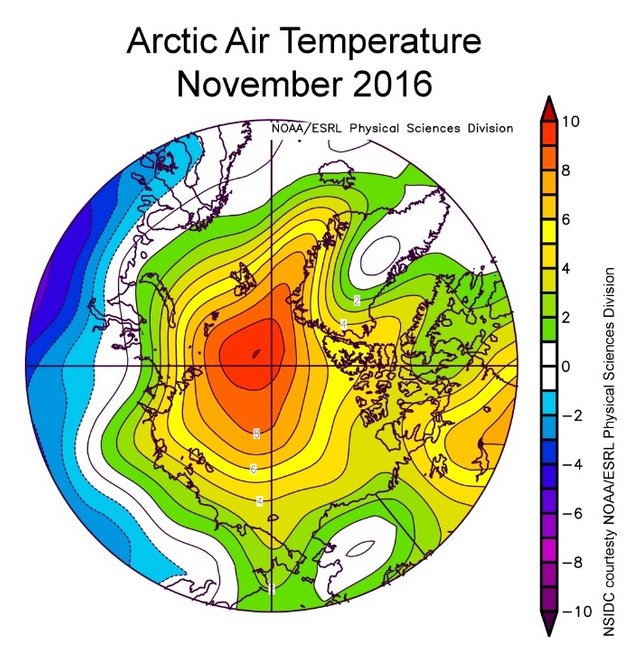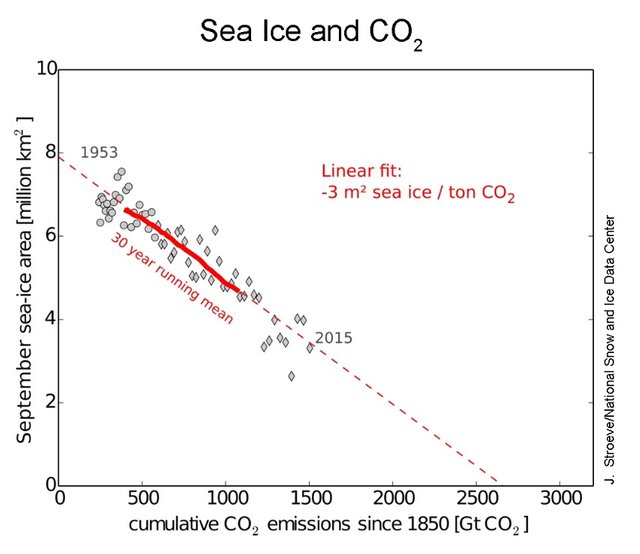
Sea ice off the coast of Antarctica and in the Arctic is at a record low for this time of year: the length of the ice sheet as at 4 December was lower than the average level of 1981-2010 gg 3.84 million km2, which is comparable to India area or two Alaska. Climatologists believe that the reason lies in the increase in global temperatures.
In recent years, contrary to the trend of global warming and the steady retreat of ice in the northern hemisphere, the ice that floated in the Southern Ocean near Antarctica, only increased. But now the ice area shrinking in both hemispheres that unreasonably disturbs scientists: the accumulation of man-made emissions of greenhouse gases in the atmosphere, a natural phenomenon El Niño, which this year has shaken the usual temperature range of the Pacific Ocean and the whims of nature clearly contributed to the current situation.
According to scientists from the National Snow and Ice Data Center, due to record high temperatures and global warming of ocean waters decreased level of Arctic sea ice in November. The same situation is observed in the southern hemisphere, where the level of sea ice fell to a record low this month.
The area of Arctic sea ice in the middle of November was 9.08 million km2, which is 1.95 million km2 below the monthly average recorded between 1981 and 2010. And although at the beginning of the month rate of increase in Arctic ice were a bit higher than the average, the total length is actually reduced for a short period in mid-November. Changing the length of 50 km2 is observed mainly in the Barents Sea near the Arctic Ocean north of Norway and Finland, as well as in the eastern part of Russia.
Scientists said that this reduction in length - almost unprecedented phenomenon of November. Less clear and brief deviation from the norm could be observed in 2013, when the melting of Arctic ice has gone beyond the norm and amounted to 14 thousand km2.

The graph blue highlighted the daily change of the level of Arctic sea ice on December 5, 2016, inclusive. In addition, in the previous figures are indicated 4 as follows: they are represented in the graph lines of green, orange, brown, and purple. Line dark gray indicate the average figures for the 1981-2010 biennium. Light gray area - the tolerance.
In November 2016 it recorded record low in 38 years of satellite monitoring. This indicator dropped by 3.2 points lower than the level of tolerance. Going outside was even more than in September 2012, when the minimum amount of Arctic ice reached a record low.

This map shows the temperature difference between the temperature of the November 2016 by the Arctic average. At the level of 925 hPa temperature in the atmosphere was higher than the average 1981-2010 years around the Arctic Ocean.
Scientists said that the high temperatures over the Arctic Ocean, persistent winds from the south and the warm waters of the ocean together led to a reduction in the extent of Arctic ice. Stretching from the northeast Greenland to Schpitsbergenu and Severnaya Zemlya, the air temperature at 925 hPa level was up to 10 ° C higher than the average 1981-2010 years during the month. These values contrast sharply with the figures in the north of Eurasia, where temperatures ranged from 4 ° C to 8 ° C below average. snow records in Sweden and throughout Siberia at the beginning of the month were recorded.
Scientists describe the possible causes of such changes. In the autumn-winter period, we can observe a cyclone passing from Iceland through the Norwegian Sea and further into the Barents Sea. In November this year, he changed the trajectory and path instead of the usual went to the Arctic Ocean through Fram Strait, which separates the archipelago of Svalbard and Greenland. Thus southerly winds were in the Fram Strait, the Eurasian Arctic and the Barents Sea, which explains the unusual warming of the Arctic Ocean. The wind also pushed the ice to the north: this explains why the sea ice in the Barents Sea retreated in November.
The temperature on the surface of the Barents and Kara Seas remained unusually high for this time of the year, which also interferes with the normal formation of ice - contributed to the circulation of the warm Atlantic water into the Arctic shelf.

The ratio between the area of sea ice in September 1953-2015 biennium and carbon dioxide emissions. Grey diamonds represent individual data values from satellites circles - the values of the pre-satellite era. Red dotted line indicates a linear relationship, a solid - a 30-year moving average.
In addition to the high temperatures and the warm currents of the sea ice loss linked to man-made emissions of carbon dioxide. Scientists have investigated this linear relationship based on the data from the satellites and to-satellite observations, climate models. The observed correlation is equivalent to a loss of 3 m2 of ice for each metric ton of carbon dioxide into the atmosphere, compared with the average of all the climate models of 1.75 m2. This result demonstrates that the model - generally conservative approach with regard to the observations about how the Arctic is losing its ice cover. The ability to monitor the rate of ice loss per metric ton of CO2 allows people to feel their own contribution to the reduction in the area of ice.
Referenced Materials:
- https://en.wikipedia.org/wiki/El_Niño
- https://en.wikipedia.org/wiki/National_Snow_and_Ice_Data_Center
- https://en.wikipedia.org/wiki/Continental_shelf_of_Russia
- https://en.wikipedia.org/wiki/Moving_average
- http://science.sciencemag.org/content/354/6313/747.full?ijkey=qgtAVB%2520WOXjw1U&keytype=ref&siteid=sci
very informative post, upvoted and followed.
Downvoting a post can decrease pending rewards and make it less visible. Common reasons:
Submit
thanks!
Downvoting a post can decrease pending rewards and make it less visible. Common reasons:
Submit
You're welcome.
Downvoting a post can decrease pending rewards and make it less visible. Common reasons:
Submit
This post has been ranked within the top 10 most undervalued posts in the second half of Dec 07. We estimate that this post is undervalued by $31.60 as compared to a scenario in which every voter had an equal say.
See the full rankings and details in The Daily Tribune: Dec 07 - Part II. You can also read about some of our methodology, data analysis and technical details in our initial post.
If you are the author and would prefer not to receive these comments, simply reply "Stop" to this comment.
Downvoting a post can decrease pending rewards and make it less visible. Common reasons:
Submit
Scientists are paid by corporations to produce a certain results ,new technology is not science just gadgets we use....we are in self adjusting closed system...
Downvoting a post can decrease pending rewards and make it less visible. Common reasons:
Submit
No more countries no more nations there is only corporations.....
Downvoting a post can decrease pending rewards and make it less visible. Common reasons:
Submit